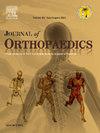Cemented vs. uncemented total knee arthroplasty in obese patients: A systematic review of implant survival, complications, and clinical outcomes
IF 1.5
Q3 ORTHOPEDICS
引用次数: 0
Abstract
Introduction
Obesity is a primary global health concern that negatively affects the outcomes of total knee arthroplasty (TKA). To mitigate complications, both cemented and uncemented fixation techniques have been considered. However, there remains no consensus in the literature regarding the optimal fixation method for obese patients despite the renewed interest in uncemented fixation. This systematic review aims to compare the survival rates, causes of failure, and patient-reported outcome measures (PROMs) between cemented TKA (cTKA) and uncemented TKA (uTKA) in the obese population.
Materials and methods
A comprehensive literature search was conducted according to PRISMA guidelines across five databases—PubMed, Scopus, Embase, Medline, and Cochrane—focusing on studies directly comparing cTKA and uTKA in obese patients. The ROBINS-I tool was used to assess the risk of bias, while the PRISMA flow diagram guided the study selection process based on predefined inclusion and exclusion criteria. This systematic review was registered on PROSPERO.
Results
Four retrospective studies encompassing 1622 patients met the inclusion criteria and were included in the final qualitative analysis. Among these, 50 % of patients underwent uTKA, with three studies exclusively analyzing individuals with at least class II obesity (BMI ≥35 kg/m2). All four studies reported higher rates of aseptic loosening in the cemented fixation group. However, only two studies demonstrated a statistically significant improvement in implant survival, reduced aseptic loosening, and lower revision rates with cementless fixation in the short-to mid-term follow-up. Regarding clinical outcomes, only one study reported a significant improvement in Knee Society Score (KSS) function, range of motion (ROM), and pain scores in the cementless group compared to the cemented group, particularly in the subgroup analysis of posterior-stabilized constrained TKA.
Conclusion
This systematic review suggests that in obese patients, particularly those with BMI ≥35 kg/m2, cementless fixation offers comparable or superior implant survival rates and lower rates of aseptic loosening compared to cemented fixation in the short-to mid-term follow-up. Furthermore, cementless fixation may provide similar or enhanced clinical outcomes in this high-risk and growing patient population.
肥胖患者的骨水泥与非骨水泥全膝关节置换术:对植入物存活、并发症和临床结果的系统回顾
肥胖是一个主要的全球健康问题,对全膝关节置换术(TKA)的结果产生负面影响。为了减轻并发症,骨水泥和非骨水泥固定技术都被考虑过。然而,关于肥胖患者的最佳固定方法,文献中仍未达成共识,尽管非骨水泥固定重新引起了人们的兴趣。本系统综述旨在比较肥胖人群中胶结TKA (cTKA)和非胶结TKA (uTKA)的生存率、失败原因和患者报告的预后指标(PROMs)。材料和方法根据PRISMA指南在pubmed、Scopus、Embase、Medline和cochrane五个数据库中进行了全面的文献检索,重点是直接比较肥胖患者cTKA和uTKA的研究。使用ROBINS-I工具评估偏倚风险,而PRISMA流程图根据预定义的纳入和排除标准指导研究选择过程。该系统综述已在PROSPERO上登记。结果4项回顾性研究包括1622例患者符合纳入标准,并被纳入最终的定性分析。其中,50%的患者接受了uTKA,有三项研究专门分析了至少II级肥胖(BMI≥35 kg/m2)的个体。所有四项研究都报道了骨水泥固定组无菌性松动的发生率较高。然而,只有两项研究表明,在中短期随访中,无骨水泥固定可以显著改善种植体存活、减少无菌性松动和降低翻修率。关于临床结果,只有一项研究报告了与骨水泥组相比,无骨水泥组在膝关节社会评分(KSS)功能、活动范围(ROM)和疼痛评分方面有显著改善,特别是在后稳定受限TKA的亚组分析中。结论:本系统综述表明,在肥胖患者中,特别是BMI≥35 kg/m2的肥胖患者,在中短期随访中,与骨水泥固定相比,无骨水泥固定具有相当或更高的种植体存活率和更低的无菌松动率。此外,在这种高风险和不断增长的患者群体中,无骨水泥固定可能提供类似或更好的临床结果。
本文章由计算机程序翻译,如有差异,请以英文原文为准。
求助全文
约1分钟内获得全文
求助全文
来源期刊

Journal of orthopaedics
ORTHOPEDICS-
CiteScore
3.50
自引率
6.70%
发文量
202
审稿时长
56 days
期刊介绍:
Journal of Orthopaedics aims to be a leading journal in orthopaedics and contribute towards the improvement of quality of orthopedic health care. The journal publishes original research work and review articles related to different aspects of orthopaedics including Arthroplasty, Arthroscopy, Sports Medicine, Trauma, Spine and Spinal deformities, Pediatric orthopaedics, limb reconstruction procedures, hand surgery, and orthopaedic oncology. It also publishes articles on continuing education, health-related information, case reports and letters to the editor. It is requested to note that the journal has an international readership and all submissions should be aimed at specifying something about the setting in which the work was conducted. Authors must also provide any specific reasons for the research and also provide an elaborate description of the results.
 求助内容:
求助内容: 应助结果提醒方式:
应助结果提醒方式:


